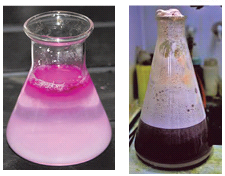Class 8 science chapter 13 Chemical Change and Chemical Bond Exercise
Important points to remember :
- During a chemical change the chemical composition of the original matter changes and new substances having different properties and different chemical compositon are formed.
- A chemical equation can be written for a chemical change, if the exact change in chemical composition is known.
- Respiration is a continuously occuring biological process. In this process, we inhale the air and exhale carbon dioxide and water vapour.
- The chemical bond formed due to an elctrostatic force of attraction between the oppositely charged cation and anion is called an ionic bond or an electrovalent bond.
- The compound formed by means of one or more ionic bonds is called ionic compound. a covalent bond is formed when atoms of two elements having similar properties combine. Such atoms cannot exchange electrons. Instead, these atoms share electrons with each other.
Question 1: Complete the statement by filling the gaps using appropriate term from the terms given in the bracket.
(slow, coloured, arrow, fast, smell, milky, physical, product, chemical, reactant, covalent, equality sign)
a. An arrow is drawn in between the reactants and products while writing the equation for a chemical reation.
b. Rusting of iron is a slow chemical change.
c. The spoiling of food is a chemical change which is recognized from the generation of certain smell due to it.
d. A colourless solution of calcium hydroxide in a test tube turns milky on blowing in it through a blow tube for some time.
e. The white particles of baking soda disappear when put in lemon juice. This means that it is a chemical change.
f. Oxygen is a reactant in respiration.
g. Sodium chloride is ionic compound while hydrogen chloride is covalent compound.
h. Electron duplet is complete in each hydrogen in a hydrogen molecule.
i. Chlorine (Cl2) molecule is formed by sharing of electrons between two chlorine atoms.
Question 2: Explain by writing a word equation.
a. Respiration is a chemical change.
Answer : Glucose is oxidised to CO2 and H2O (along with release of energy) at the cells by the oxygen from air we breathe in. Since glucose is converted into new products with different composition, respiration is a chemical change.
b. Hard water gets softened on mixing with a solutions of washing soda.
Answer : Hard water can be softened by adding washing soda (sodium carbonate) which removes the calcium ions in a precipitation reaction. Alternatively, the hard water can be passed through an ion-exchange resin in a column.
c. Lime stone powder disappears on adding to dilute hydrochloric acids.
Answer : The lime stone(calcium carbonate)reacts with hydrochloric acid and three products are formed. One of them is calcium chloride which being soluble in water and get washed away with water. Calcium carbonate+ hydrochloric acid=calcium chloride+ carbon dioxide+ water.
d. Bubbles are seen on adding lemon juice to baking soda.
Answer : Lemons and other citrus fruits are rich sources of naturally-occurring citric acid. When a person mixes lemon juice and baking soda, the citric acid reacts with the sodium bicarbonate to produce a buffer called sodium citrate. A buffer refers to a weak acid or base that prevents drastic pH changes.
Question 3: Match the pairs.
a. Photosynthesis i. Tendency to lose. electrons
b. Water ii. Reactant in. combustion process
c. Sodium chloride iii. Chemical change
d. Dissolution of
salt in water iv. Covalent bond
e. Carbon v. Ionic bond
f. Fluorine vi. physical change
g. Magnesium vii. Tendency to form. anion
Answer :
a. Photosynthesis – i. Chemical change
b. Water – ii. Covalent bond
c. Sodium chloride – iii. Ionic bond
d. Dissolution of salt in water – iv. Physical change
e. Carbon – v. Reactant in combustion process
f. Fluorine – vi. Tendency to form anion
g. Magnesium – vii. Tendency to lose electrons
Question 4: Show with the heip of diagram of electronic configuration how the following compound are formed from the constituent atoms.
a. Sodium chloride
b. Potassium fluoride
c.Water
d. Hydrogen chloride
# Can you Recall
1. What are the methods of classification of changes ?
Answer : Physical and Chemical Changes. We see ice melting into water, water boiling to vapours and vapours precipitating into the water droplets oncooling. These are some of the examples of Physical Changes since the transition is in the Physical Properties of Water. Substances in Nature undergo various types of changes.
2. What is the difference between physical and chemical change ?
Answer : The difference between a physical reaction and a chemical reaction is composition. In a chemical reaction, there is a change in the composition of the substances in question; in a physical change there is a difference in the appearance, smell, or simple display of a sample of matter without a change in composition.
Tags : heat and temperature class 8, explain by writing a word equation respiration is a chemical change, questions on heat for class 8, std 8 science chapter 13 ssc, 8th class science syllabus, class 8 science notes state board, std 8 science chapter 12, introduction to acid and base exercise, class 8 science notes state board, ssc 8th class science syllabus, ybstudy maharashtra state board class 8, heat and temperature class 8, std 8 science chapter 13 measurement and effects of heat exercises explain by writing a word equation respiration is a chemical change





